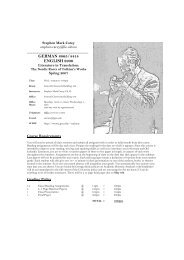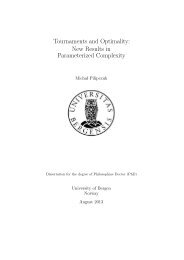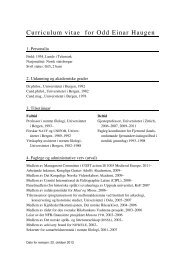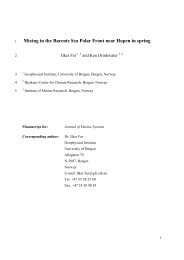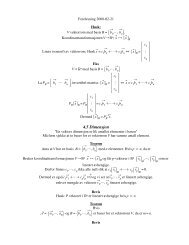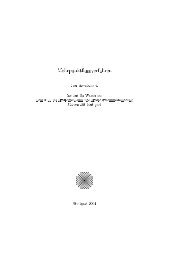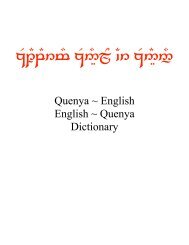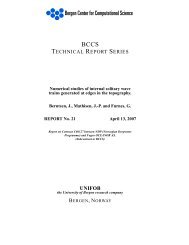Rational Curves in Calabi-Yau Threefolds
Rational Curves in Calabi-Yau Threefolds
Rational Curves in Calabi-Yau Threefolds
You also want an ePaper? Increase the reach of your titles
YUMPU automatically turns print PDFs into web optimized ePapers that Google loves.
<strong>Rational</strong> <strong>Curves</strong> <strong>in</strong> <strong>Calabi</strong>-<strong>Yau</strong> <strong>Threefolds</strong> 3931<br />
5.1. Some General Facts About K3 Surfaces<br />
Recall that a K3 surface is a (reduced and irreducible) surface S with<br />
trivial canonical bundle and such that H 1 (OS) ¼ 0. In particular h 2 (OS) ¼ 1<br />
and w(OS) ¼ 2.<br />
We will use l<strong>in</strong>e bundles and divisors on a K3 surface with little or no<br />
dist<strong>in</strong>ction, as well as the multiplicative and additive notation, and denote<br />
l<strong>in</strong>ear equivalence of divisors by .<br />
Before cont<strong>in</strong>u<strong>in</strong>g, we briefly recall some useful facts and some of the<br />
ma<strong>in</strong> results <strong>in</strong> Johnsen and Knutsen (2001) which will be used <strong>in</strong> the<br />
proof of Theorem 4.3.<br />
Let C be a smooth irreducible curve of genus g 2 and A a l<strong>in</strong>e<br />
bundle on C. The Clifford <strong>in</strong>dex of A (<strong>in</strong>troduced by Martens (1968) is<br />
the <strong>in</strong>teger<br />
Cliff A ¼ deg A 2ðh 0 ðAÞ 1Þ:<br />
If g 4, then the Clifford <strong>in</strong>dex of C itself is def<strong>in</strong>ed as<br />
Cliff C ¼ m<strong>in</strong>fCliff Ajh 0 ðAÞ 2; h 1 ðAÞ 2g:<br />
Clifford’s theorem then states that Cliff C 0 with equality if and only<br />
if C is hyperelliptic and Cliff C ¼ 1 if and only if C is trigonal or a smooth<br />
plane qu<strong>in</strong>tic.<br />
At the other extreme, we obta<strong>in</strong> from Brill-Noether theory (cf.<br />
g 1<br />
Arbarello et al., 1985, Chapter V) that Cliff C b c. For the general<br />
curve of genus g, we have Cliff C ¼b<br />
g 1<br />
2 c.<br />
We say that a l<strong>in</strong>e bundle A on C contributes to the Clifford <strong>in</strong>dex of<br />
C if h 0 (A), h 1 (A) 2 and that it computes the Clifford <strong>in</strong>dex of C if <strong>in</strong><br />
addition Cliff C ¼ Cliff A.<br />
Note that Cliff A ¼ Cliff oC A 1 .<br />
It was shown by Green and Lazarsfeld (1987) that the Clifford <strong>in</strong>dex<br />
is constant for all smooth curves <strong>in</strong> a complete l<strong>in</strong>ear system jLj on a K3<br />
surface. Moreover, they also showed that if Cliff C < b<br />
2<br />
g 1<br />
2<br />
c (where g<br />
denotes the sectional genus of L, i.e., L 2 ¼ 2g 2), then there exists a l<strong>in</strong>e<br />
bundle M on S such that MC :¼ M OC computes the Clifford <strong>in</strong>dex of C<br />
for all smooth irreducible C 2jLj.<br />
This was <strong>in</strong>vestigated further <strong>in</strong> Johnsen and Knutsen (2001), where<br />
we def<strong>in</strong>ed the Clifford <strong>in</strong>dex of a base po<strong>in</strong>t free l<strong>in</strong>e bundle L on a K3<br />
surface to be the Clifford <strong>in</strong>dex of all the smooth curves <strong>in</strong> jLj and<br />
denoted it by Cliff L. Similarly, if (S, L) is a polarized K3 surface, we<br />
def<strong>in</strong>ed the Clifford <strong>in</strong>dex of S, denoted by CliffL(S) tobeCliffL.



